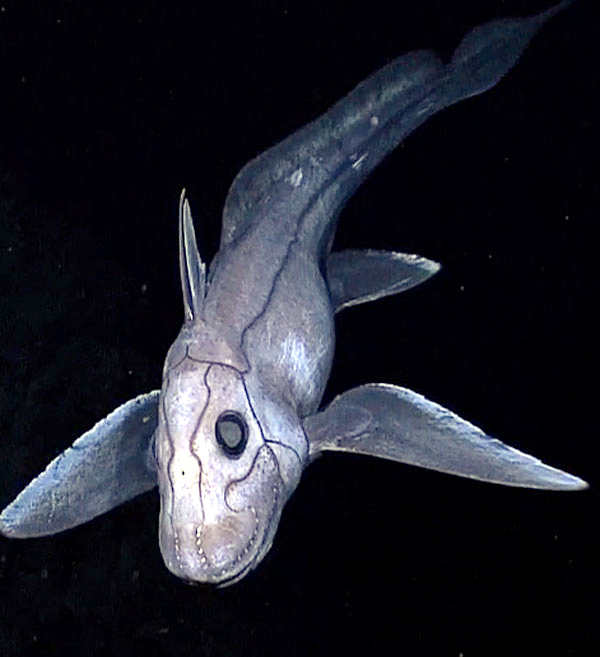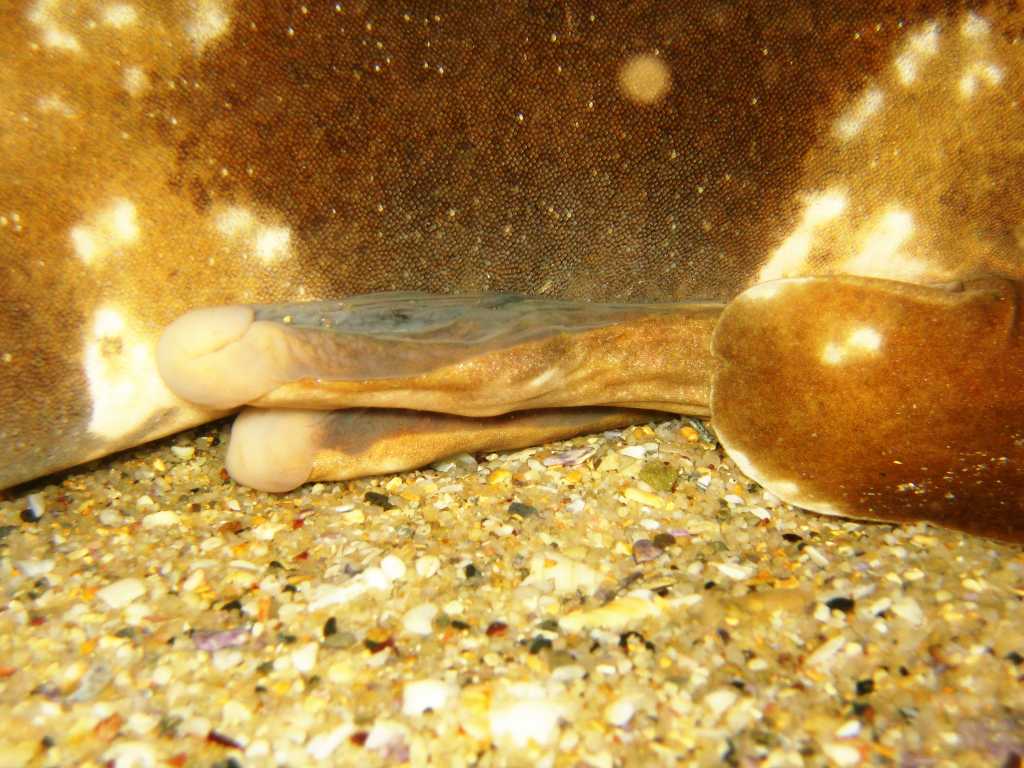|
Large-eyed Rabbitfish
The large-eyed rabbitfish (''Hydrolagus mirabilis'') is a species of fish in the family Chimaeridae. It is found in several areas of the Atlantic Ocean and within the Mediterranean Sea. Distribution There are reported sightings of ''Hydrolagus mirabilis'' that stretch from Southern Africa on the coast of Namibia all the way to the far north of Iceland. The most recent accounts come from Syrian waters (500m) within the eastern Mediterranean Sea and the Bay of Biscay between Spain and France. The family Chimaeridae is present worldwide within temperate to tropical waters, below 200m, but prefer to swim within coastal environments. Young members have a tendency to remain at lower depths than the older members, who are more focused on inshore mating and migrations. Description The size of this species ranges from 600–2000 mm, displaying sexual dimorphism where the females are significantly larger than the males. The large pectoral wing like fins on the sides of i ... [...More Info...] [...Related Items...] OR: [Wikipedia] [Google] [Baidu] |
Robert Collett
Robert Collett (2 December 1842 – 27 January 1913) was a Norwegian zoologist. Collett was director and curator of the Zoological Museum at University of Oslo. Robert Collett was born at Christiania (now Oslo), Norway. He was the eldest child of Professor Peter Jonas Collett (1813–51) and Camilla Collett (1813–95). His maternal uncles included Oscar and Henrik Wergeland, and his paternal uncles included Peter Severin Steenstrup. He had three younger brothers, including the writer and historian, Alf Collett. He never married.Robert Collett University of Oslo He attended the Latin School in and was a fellow in zoology at the |
Chimaera
Chimaeras are cartilaginous fish in the order Chimaeriformes , known informally as ghost sharks, rat fish, spookfish, or rabbit fish; the last three names are not to be confused with rattails, Opisthoproctidae, or Siganidae, respectively. At one time a "diverse and abundant" group (based on the fossil record), their closest living relatives are sharks and rays, though their last common ancestor with them lived nearly 400 million years ago. Today, they are largely confined to deep water. Description and habits Chimaeras live in temperate ocean floors down to deep, with few occurring at depths shallower than . Exceptions include the members of the genus ''Callorhinchus'', the rabbit fish and the spotted ratfish, which locally or periodically can be found at shallower depths. Consequently, these are also among the few species from the chimaera order kept in public aquaria. They live in all the oceans except for the Arctic and Antarctic oceans. They have elongated, soft ... [...More Info...] [...Related Items...] OR: [Wikipedia] [Google] [Baidu] |
Fish Of The Atlantic Ocean
Fish are aquatic, craniate, gill-bearing animals that lack limbs with digits. Included in this definition are the living hagfish, lampreys, and cartilaginous and bony fish as well as various extinct related groups. Approximately 95% of living fish species are ray-finned fish, belonging to the class Actinopterygii, with around 99% of those being teleosts. The earliest organisms that can be classified as fish were soft-bodied chordates that first appeared during the Cambrian period. Although they lacked a true spine, they possessed notochords which allowed them to be more agile than their invertebrate counterparts. Fish would continue to evolve through the Paleozoic era, diversifying into a wide variety of forms. Many fish of the Paleozoic developed external armor that protected them from predators. The first fish with jaws appeared in the Silurian period, after which many (such as sharks) became formidable marine predators rather than just the prey of arthropods. Most ... [...More Info...] [...Related Items...] OR: [Wikipedia] [Google] [Baidu] |
Hydrolagus
''Hydrolagus'' is a genus of fish in the family Chimaeridae found in the Atlantic, Indian and Pacific Oceans.Weigmann, S. (2016)Annotated checklist of the living sharks, batoids and chimaeras (Chondrichthyes) of the world, with a focus on biogeographical diversity.''Journal of Fish Biology, 88 (3): 837-1037.'' Species The 23 recognized species in this genus are: * '' Hydrolagus affinis'' ( Brito Capello ( pt), 1868) (small-eyed rabbitfish) * '' Hydrolagus africanus'' ( Gilchrist, 1922) (African chimaera) Walovich, K.A., Ebert, D.A., Long, D.J. & Didier, D.A. (2015)Redescription of ''Hydrolagus africanus'' (Gilchrist, 1922) (Chimaeriformes: Chimaeridae), with a review of southern African chimaeroids and a key to their identification.''African Journal of Marine Science, 37 (2): 157-165.'' * ''Hydrolagus alberti'' Bigelow & Schroeder, 1951 (gulf chimaera) * ''Hydrolagus alphus'' Quaranta, Didier, Long & Ebert, 2006 (whitespot ghost shark) * '' Hydrolagus barbouri'' (Garman, 1908) ... [...More Info...] [...Related Items...] OR: [Wikipedia] [Google] [Baidu] |
Crustacean
Crustaceans (Crustacea, ) form a large, diverse arthropod taxon which includes such animals as decapods, seed shrimp, branchiopods, fish lice, krill, remipedes, isopods, barnacles, copepods, amphipods and mantis shrimp. The crustacean group can be treated as a subphylum under the clade Mandibulata. It is now well accepted that the hexapods emerged deep in the Crustacean group, with the completed group referred to as Pancrustacea. Some crustaceans (Remipedia, Cephalocarida, Branchiopoda) are more closely related to insects and the other hexapods than they are to certain other crustaceans. The 67,000 described species range in size from '' Stygotantulus stocki'' at , to the Japanese spider crab with a leg span of up to and a mass of . Like other arthropods, crustaceans have an exoskeleton, which they moult to grow. They are distinguished from other groups of arthropods, such as insects, myriapods and chelicerates, by the possession of biramous (two-parted) limbs, and by th ... [...More Info...] [...Related Items...] OR: [Wikipedia] [Google] [Baidu] |
Amphiprioninae
Clownfish or anemonefish are fishes from the subfamily Amphiprioninae in the family Pomacentridae. Thirty species of clownfish are recognized: one in the genus ''Premnas'', while the remaining are in the genus ''Amphiprion''. In the wild, they all form symbiotic mutualisms with sea anemones. Depending on the species, anemonefish are overall yellow, orange, or a reddish or blackish color, and many show white bars or patches. The largest can reach a length of , while the smallest barely achieve . Distribution and habitat Anemonefish are endemic to the warmer waters of the Indian Ocean, including the Red Sea, and Pacific Ocean, the Great Barrier Reef, Southeast Asia, Japan, and the Indo-Malaysian region. While most species have restricted distributions, others are widespread. Anemonefish typically live at the bottom of shallow seas in sheltered reefs or in shallow lagoons. No anemonefish are found in the Atlantic. Diet Anemonefish are omnivorous and can feed on undigested food ... [...More Info...] [...Related Items...] OR: [Wikipedia] [Google] [Baidu] |
Echinoderm
An echinoderm () is any member of the phylum Echinodermata (). The adults are recognisable by their (usually five-point) radial symmetry, and include starfish, brittle stars, sea urchins, sand dollars, and sea cucumbers, as well as the sea lilies or "stone lilies". Adult echinoderms are found on the sea bed at every ocean depth, from the intertidal zone to the abyssal zone. The phylum contains about 7,000 living species, making it the second-largest grouping of deuterostomes, after the chordates. Echinoderms are the largest entirely marine phylum. The first definitive echinoderms appeared near the start of the Cambrian. The echinoderms are important both ecologically and geologically. Ecologically, there are few other groupings so abundant in the biotic desert of the deep sea, as well as shallower oceans. Most echinoderms are able to reproduce asexually and regenerate tissue, organs, and limbs; in some cases, they can undergo complete regeneration from a single limb. ... [...More Info...] [...Related Items...] OR: [Wikipedia] [Google] [Baidu] |
Mollusca
Mollusca is the second-largest phylum of invertebrate animals after the Arthropoda, the members of which are known as molluscs or mollusks (). Around 85,000 extant species of molluscs are recognized. The number of fossil species is estimated between 60,000 and 100,000 additional species. The proportion of undescribed species is very high. Many taxa remain poorly studied. Molluscs are the largest marine phylum, comprising about 23% of all the named marine organisms. Numerous molluscs also live in freshwater and terrestrial habitats. They are highly diverse, not just in size and anatomical structure, but also in behaviour and habitat. The phylum is typically divided into 7 or 8 taxonomic classes, of which two are entirely extinct. Cephalopod molluscs, such as squid, cuttlefish, and octopuses, are among the most neurologically advanced of all invertebrates—and either the giant squid or the colossal squid is the largest known invertebrate species. The gastropod ... [...More Info...] [...Related Items...] OR: [Wikipedia] [Google] [Baidu] |
Polychaete
Polychaeta () is a paraphyletic class (biology), class of generally marine invertebrate, marine annelid worms, common name, commonly called bristle worms or polychaetes (). Each body segment has a pair of fleshy protrusions called parapodia that bear many bristles, called chaetae, which are made of chitin. More than 10,000 species are described in this class. Common representatives include the lugworm (''Arenicola marina'') and the Alitta virens, sandworm or Alitta succinea, clam worm ''Alitta''. Polychaetes as a class are robust and widespread, with species that live in the coldest ocean temperatures of the abyssal plain, to forms which tolerate the extremely high temperatures near hydrothermal vents. Polychaetes occur throughout the Earth's oceans at all depths, from forms that live as plankton near the surface, to a 2- to 3-cm specimen (still unclassified) observed by the robot ocean probe Nereus (underwater vehicle), ''Nereus'' at the bottom of the Challenger Deep, the deepes ... [...More Info...] [...Related Items...] OR: [Wikipedia] [Google] [Baidu] |
Oviparity
Oviparous animals are animals that lay their eggs, with little or no other embryonic development within the mother. This is the reproductive method of most fish, amphibians, most reptiles, and all pterosaurs, dinosaurs (including birds), and monotremes. In traditional usage, most insects (one being ''Culex pipiens'', or the common house mosquito), molluscs, and arachnids are also described as oviparous. Modes of reproduction The traditional modes of reproduction include oviparity, taken to be the ancestral condition, traditionally where either unfertilised oocytes or fertilised eggs are spawned, and viviparity traditionally including any mechanism where young are born live, or where the development of the young is supported by either parent in or on any part of their body. However, the biologist Thierry Lodé recently divided the traditional category of oviparous reproduction into two modes that he named ovuliparity and (true) oviparity respectively. He distinguished the tw ... [...More Info...] [...Related Items...] OR: [Wikipedia] [Google] [Baidu] |
Clasper
In biology, a clasper is a male anatomical structure found in some groups of animals, used in mating. Male cartilaginous fish have claspers formed from the posterior portion of their pelvic fin which serve to channel semen into the female's cloaca during mating. The act of mating in some fish including sharks usually includes one of the claspers raised to allow water into the siphon through a specific orifice. The clasper is then inserted into the cloaca, where it opens like an umbrella to anchor its position. The siphon then begins to contract, expelling water and sperm. The claspers of many shark species have spines or hooks, which may hold them in place during copulation. Male chimaeras have cephalic claspers (tenacula) on their heads, which are thought to aid in holding the female during mating. In entomology, it is a structure in male insects that is used to hold the female during copulation (see Lepidoptera genitalia for more). See also *Sexual coercion among animals ... [...More Info...] [...Related Items...] OR: [Wikipedia] [Google] [Baidu] |
Internal Fertilization
Internal fertilization is the union of an egg and sperm cell during sexual reproduction inside the female body. Internal fertilization, unlike its counterpart, external fertilization, brings more control to the female with reproduction. For internal fertilization to happen there needs to be a method for the male to introduce the sperm into the female's reproductive tract. Most taxa that reproduce by internal fertilization are gonochoric. In mammals, reptiles, and certain other groups of animals, this is done by copulation, an intromittent organ being introduced into the vagina or cloaca. In most birds, the cloacal kiss is used, the two animals pressing their cloacas together while transferring sperm. Salamanders, spiders, some insects and some molluscs undertake internal fertilization by transferring a spermatophore, a bundle of sperm, from the male to the female. Following fertilization, the embryos are laid as eggs in oviparous organisms, or continue to develop inside the ... [...More Info...] [...Related Items...] OR: [Wikipedia] [Google] [Baidu] |








